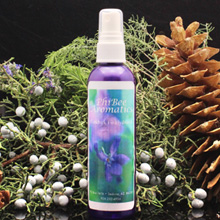Medicinal and Aromatic Plants of Arizona by Clare Licher
Published in the IFPA Journal, In Essence
Summer 2021
When Clare Licher relocated to the mountains of Arizona three decades ago she began a journey of discovery into the world of native plants and the art of essential oil distillation
In November 1991, I moved from the Pacific Northwest of the United States to the mountains of Northern Arizona. I might as well have moved to another planet! With the exception of pine, juniper and oak trees there were no other native plants that I recognised. I had a few days to marvel at this new landscape before being snowed in with a massive snowstorm. Little did I know at the time that this would create a superbloom of numerous species, on a scale that the regional botanists had not observed in close to 30 years. It would also ignite my passion for the native plants that still persists today.
 A beautiful carpet of Cream cups (Platystemon californicus) and Owl clover (Castilleja exserta) photographed near Sedona, Arizona, USA |
That spring I enrolled in a native plant class at a nearby college and bought copies of the ethnobotanical books Medicinal Plants of the Desert and Canyon West, and Medicinal Plants of the Mountain West, both by the late Michael Moore. These books accompanied me to every class and on every field trip so that, as I learned to identify the plants, I also learned their medicinal benefits.
I began wildcrafting herbs, making teas, tinctures, infusions, decoctions, and using oil infusions in lip balms and salves. I soon met my future husband, Max, who also had an interest in native plants, and we went on many plant walks together with outstanding local herbalists. At this time we had only a vague awareness of aromatherapy but had noticed that many of the plants were very aromatic.
Discovering aromatherapy
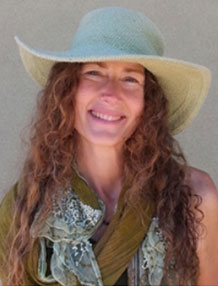 It wasn’t until early 1997 that I truly discovered
aromatherapy. Our 13-month-old baby was diagnosed
with a severe case of bilateral congenital hip dysplasia,
which would require several major surgeries to give her
a chance of ever being able to walk normally. We were
desperate to try anything that might help her. A nurse
recommended that we purchase Frankincense and Birch
essential oils to strengthen her bones. Her issue was
structural and I felt fairly certain that it was beyond the
scope of what an essential oil could alter, but we bought
the recommended oils and several others to aid her
healing process.
It wasn’t until early 1997 that I truly discovered
aromatherapy. Our 13-month-old baby was diagnosed
with a severe case of bilateral congenital hip dysplasia,
which would require several major surgeries to give her
a chance of ever being able to walk normally. We were
desperate to try anything that might help her. A nurse
recommended that we purchase Frankincense and Birch
essential oils to strengthen her bones. Her issue was
structural and I felt fairly certain that it was beyond the
scope of what an essential oil could alter, but we bought
the recommended oils and several others to aid her
healing process.
It was a very distressing time for us and I was having frequent migraine headaches. One afternoon during a particularly bad episode I asked Max to rub some Frankincense essential oil into pressure points on the top of my shoulders and around my shoulder blades. Within about five minutes the migraine, which could have lasted for days, was gone. This was my first experience of a direct physiological effect from an essential oil and I was thrilled.
Our daughter was in a body cast for six months. When she was released, her legs and hips were frozen in the position of the cast. I massaged her hips and stiff muscles with the Frankincense and Birch oils and found that the aroma also uplifted our spirits. She spent another three months in a brace. When it came off, the doctors told us it would be three months before she could stand and six months before she would walk. However, with the massage and many other therapies that we gave her, she was on her feet in six weeks and walking in three months. She healed remarkably well and has been able to live a full life with only a few minor limitations.
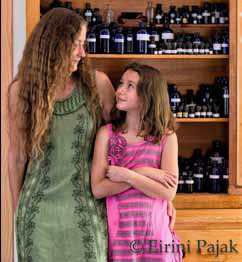 Clare (left) with daughter Arabella in the family-run distillery |
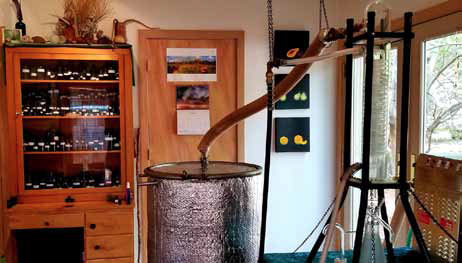 PhiBee Aromatics, a company that grew out of a passion for the natural plant world, distils native and cultivated essential oils from Arizona and California |
In exploring this new realm of plant medicine it did not take long to notice that, in the world of aromatherapy, it was difficult to find any oils from native aromatic plants of the Southwest of the USA. Max and I began a conversation about this and started researching to find out whether anyone was distilling in the region, and what plants they were working with. We met one distiller in Southern California, and found one research project carried out by two University of Arizona graduate students (McCaughey & Buehrer, 1961). Many of the report’s conclusions concerning distilling the native plants, such as ‘foul odor’ and ‘no oil obtained’ were not overly promising, yet our interest continued.
The native plant distillation conversation lasted for eight years until, in 2005, we enrolled in a weekend aromatherapy workshop. We were so inspired that we finally decided to buy a small distillation system and try it ourselves. We compiled a list of every native aromatic plant we could think of, obtained collection permits from the US Forest Service and started experimenting.
First steps in distillation
For two years we worked enthusiastically with our 20-litre distillation system, distilling many herbaceous plants such as Mexican arnica (Heterotheca subaxillaris), Mariola (Parthenium incana), Bee balm or Wild oregano (Monarda menthafolia), Lemon bee balm (Monarda citriodora), and others such Arizona juniper berry (Juniperus arizonica), and Lomatium root (Lomatium dissectum).
Many of the cultivated plants from our garden such as Cleveland sage (Salvia clevelandii), White sage (Salvia apiana), Rosemary (Rosmarinus officinalis ct pinene), Clary sage (Salvia sclarea), Lemon catnip (Nepeta cataria ssp citriodora) and Lavender (Lavandula angustifolia) were also intriguing and beautiful to work with.
Southwest plants often have a very low yield of essential oil and, while we were fully enjoying the process of distilling, we also hoped to create more than just a few tiny bottles of oil. We were very eager to work with trees and knew that we would need more plant material to have any significant yield. In complete agreement, in 2007 we purchased a 200-litre distillation system that we still use today. At this time we also invested in the out of print, six-volume treatise on essential oil distillation, The Essential Oils by Ernest Guenther PhD. Very few of the native plants we were working with were mentioned in these books, but they did help because we could often read about distilling related species.
As we began working with trees and more shrubs, our wildcrafting range expanded to include the Mohave Desert in western Arizona, the northern Sonoran Desert, the Mogollon Rim, the Coconino Plateau (near the south rim of the Grand Canyon), the Kaibab Plateau (near the north rim of the Grand Canyon), the San Francisco Peaks (near Flagstaff), the White Mountains in eastern Arizona, and the greater Verde Valley.
Exciting potential
With so many varied ecosystems, and over 4,000 species of plants in Arizona, the potential was very exciting. Over the next couple of years we distilled seven different species of Juniper (Juniperus arizonica, californica, communis var neglecta, deppeana, monosperma, osteosperma, and scopulorum), three species of Pine (Pinus edulis, ponderosa and strobiformis) and their cones, three Firs (Abies concolor, lasiocarpa and lasiocarpa var arizonica) and Douglas fir (Pseudotsuga menziesii), five Ericameria (laricifolia, nauseousa var graveolens, var hololeuca, var oreophila, and paniculata), four native and naturalised Mints (Mentha citrata, x piperita, spicata, and poleomentha incana), Artemisia (filifolia and tridentata), Blue spruce (Picea pungens), Snakeweed (Gutierezzia sarothrae), Desert lavender (Hyptis emoryi), Wild yarrow (Achillea millefolium) and numerous other woody, shrubby and herbaceous plants.
In working with so many different species, it was important to learn the set of optimal conditions for achieving the best yield and highest quality of oil from each plant. Since it sometimes took many experiments with the same plant to determine what worked best we compiled a distillation notebook to record the details of the process. These details include the date and region of collection, date of distillation, weather conditions prior to and on the date of collection, fresh or dried plant material, weight of plant material, yield of essential oil, and other special notes such as phase of flowering, seed maturity or unusual terrain.
Some of the early distillations were disappointing when we failed to yield any essential oil but we learned something every time, which added to our knowledge of how to work best with each plant. After several years an annual distillation schedule just naturally developed and we were making oil.
Word got around (mainly because we couldn’t stop talking about it) and we were asked by several different local organisations to conduct distillation workshops. At every workshop we were asked the same two questions. “What is this oil good for?” and “How do I use it?” I could speak at length about wildcrafting, the distillation process, and how the native plants are used herbally, but I had inadequate knowledge to answer these two questions with confidence.
Our experience showed us that sometimes there are differences between the traditional herbal uses and the essential oil uses of a plant. A beautiful example of this is Sand Sagebrush (Artemisia filifolia). We were quite excited about distilling this plant, so we packed up our girls (there were two now) and drove about three hours north to the region of the Vermilion Cliffs. Our youngest daughter had a persistent spastic cough that had lasted for several weeks, in spite of our efforts. She coughed during the entire drive up, and while we were collecting. We got back in our car with the bags of plant material and, as the aromatic vapours released from the plants and filled the car, her coughing ceased. She did not cough again until we got out of the car.
Traditionally, this plant is used as an aid for indigestion, biliousness, flatulence, and for soothing inflammation in the gastrointestinal mucosa. It is also a dermatological aid for boils and bites but I could find no reference to its respiratory use. We found that the essential oil did indeed have strong respiratory benefits. I had a GC/MS report done of the essential oil, but this did not help because I could not understand it.
Building confidence
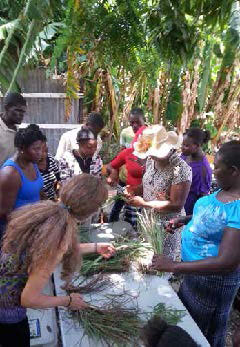 Clare with local people processing lemongrass in Grand Goave, Haiti on a Farmer-2-Farmer Volunteer Project sponsored by Prosperity Catalyst and Partners of the Americas |
This question about Sand sagebrush, and many other questions, compelled me to enrol in a 235-hour Aromatherapy Certification Program. This was exactly what I needed to bridge the gaps in my knowledge of the oils. Thanks to this program, I was able to learn about aromatic chemistry, and how to use and blend the oils safely. I could finally write and speak with confidence about the numerous health benefits of the essential oils of the Southwest. This enabled me to launch our PhiBee Aromatics website in 2013 (named after our two girls, Sophia and Arabella Bee). I was excited to get the oils out into the world, but I never dreamed what wonderful opportunities would arise from this.
I have been very fortunate to have been sponsored to speak and lead distillation training in many other countries. It has been very fulfilling to share my experience, and to form what I know will be lifelong friendships with people from other cultures. Every time I visit another place and am introduced to the people, landscape and plant life, I feel blessed by a greater sense of our global connection.
Since I was in my early 20s, I have believed that the earth is a living being, but I had not truly internalised this. The earth was simply too big an organism and I had not yet been able to observe the similarities between aspects of the landscape and our own body systems.
The plants opened my eyes to this. When we started working with them I mainly thought about what they offered us in terms of food and medicine. Later, as I began to observe when and where they appeared in the landscape, I started to see more about their roles within ecosystems and how they respond to changes. I realised that they are not just here to sustain us, they are also here to sustain the health and balance of the planet.
Some show up in the landscape to heal wounds and trauma, while others filter, purify, or provide stability. Some are first responders to burns, before the next wave of healing plants arrive. I now view plants as an integral part of the earth’s immune, healing and regulatory systems. Every earth process has a correlation to something in our bodies. Once I could see this, the living, breathing earth came to life in my heart. My feeling of connection to it deepened and became more meaningful.
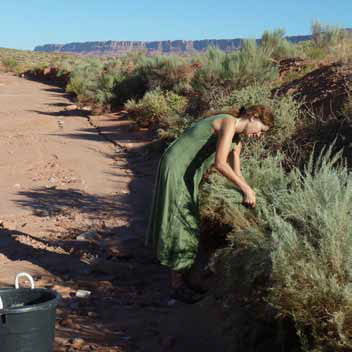 Collecting Sand sagebrush in the Vermilion Cliffs region. |
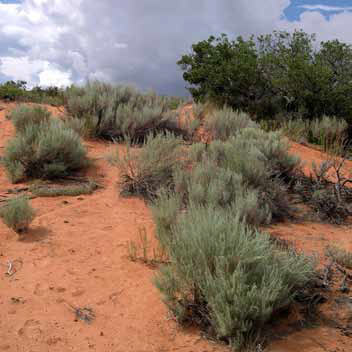 Sand sagebrush (Artemisia filifolia) |
Relationship with nature
Plants have purpose, sensitivity and cycles that we know very little about. While they all have lives of their own, they also exist completely in relationship to everything around them. I have seen plants with specific medicinal benefits suddenly appear and surround the house of a person who needed exactly what they offer. In my own herb garden, nine different species of plants ‘volunteered’, many of which were non-native plants. They were exactly what I needed to assist me in perimenopause.
Twenty-nine years after I moved to Arizona, another superbloom occurred, of the same species that I had witnessed in the spring of 1992. Is there a 29-year cycle for these plants? If so, is it based on weather patterns, or an extended period of seed scarification? Are there more subtle influences? I hope I am still here in 29 years to see if they appear again in their profuse beauty.
Wildcrafting is not just about cutting plants, it is a relationship with them and with the forest or region where they live. Before we begin, we always take a quiet moment to give thanks and to acknowledge that we are receiving a gift. This also helps us to transition out of our busy lives and to be more present. We do not wish to harm the plants that we are working with. It is vitally important that they are able to continue thriving and adding to the seed bank. In using careful practices a feeling of reciprocity builds, and in returning to the same places over and over, there is a recognition that begins to happen. It is like seeing old friends again.
Working with plants and distilling their essential oils has been a beautiful journey. In my experience, the natural world is highly interactive, communicative, and generous. The exchanges, communications and gifts from nature are a true magic. This is a magic that asks no price, is priceless, and it’s available to every human being.
Bibliography
Moore M (1989) Medicinal Plants of the Desert and Canyon West, Museum of New Mexico Press. Kane C W (2006) Herbal Medicine of the American Southwest, Lincoln Town Press. Moerman D (2009) Native American Medicinal Plants, an Ethnobotanical Dictionary, Timber Press.
Reference
McCaughey WF & Buehrer TF (1961) Essential Oil Plants of Southern Arizona, Journal of Pharmaceutical Sciences, Vol. 50, No. 8, August
Clare Licher began studying and working with the Southwestern native medicinal plants when she moved to Arizona in 1991. In 2005, she and her husband Max bought their first distillation system, and have since distilled over 110 different species of plants. Completing a NAHA- and AIA-approved Aromatherapy Certification Program in 2012 Clare now writes and speaks, both nationally and internationally, on the essential oils of the US Southwest. She has also conducted many volunteer essential oil trainings in Haiti and Jamaica, sponsored by Partners of the Americas and Prosperity Catalyst, and consults on international distillation projects. For more information visit www.phibeearomatics.com


